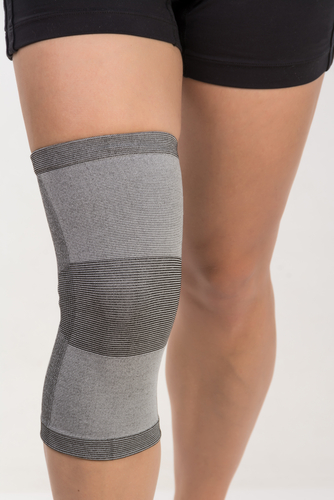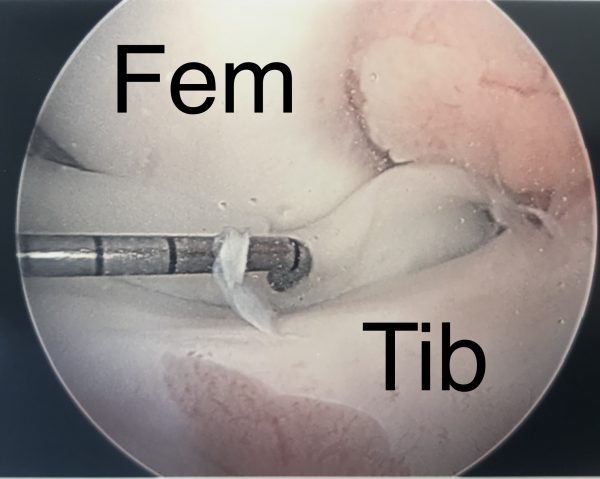What is the best treatment for a torn meniscus?
Meniscus tear treatment is actually a pretty complex issue. In the past, it was simple: take it out! However, that idea is outdated now. In this article, I will talk about many of the ways to treat meniscus tears. I’ll also tell you about some of the reasons we choose different torn meniscus treatments.
We can treat meniscus tears with:
- braces
- anti-inflammatories
- Injections
- physical therapy
- Surgery
Surgery is usually arthroscopic. We can either trim out the damaged meniscus or we can repair the torn meniscus. If you would like more information about the meniscus, symptoms of a meniscus tear, and how to prevent them, check out my previous post.
Braces for Meniscus Tear Treatment
 Braces are a good option for suspected meniscus tears. This is basic treatment before you get an MRI. If you injured your knee, wearing a brace can help you feel better by reducing swelling and keeping the knee stable. This can give the meniscus a chance to heal. But if the meniscus has not healed in six to eight weeks, it probably won’t heal on its own.
Braces are a good option for suspected meniscus tears. This is basic treatment before you get an MRI. If you injured your knee, wearing a brace can help you feel better by reducing swelling and keeping the knee stable. This can give the meniscus a chance to heal. But if the meniscus has not healed in six to eight weeks, it probably won’t heal on its own.
Braces can also be helpful for short-term treatment of meniscus tears. If you have a meniscus tear, wearing a brace may allow you to participate in an important competition. But it’s not a great long-term solution. Once you are done with The Main Event, treat your meniscus tear properly! Otherwise, you are simply letting that damaged meniscus beat up the knee and cause arthritis. Having a damaged meniscus in there is like having sand in your engine.
Anti-inflammatories for Meniscus Tear Treatment
Anti-inflammatories are available in any drugstore in the US. They are also called NSAIDs (nonsteroidal anti-inflammatories). These include medications like ibuprofen, naproxen, and aspirin. You can read more about them via this link. Many of the supplements listed our previous post are also effective anti-inflammatories.
NSAIDs can help reduce the pain and swelling caused by meniscus tears. And just like braces, they are a good short-term option. But anti-inflammatories don’t treat meniscus tears in the long term. NSAIDs won’t help meniscus tears heal. And using them for months at a time will only mask the problem.
Injections for Meniscus Tear Treatment
I generally use injections just as I use NSAIDs. They are a short-term solution. But they don’t help the meniscus heal. They are, however, a great solution if you need to feel better fast. If you need to get through a competition or just a vacation before surgery, these can help! But injections damage cartilage when done repeatedly. Which is obviously the wrong way to go for otherwise healthy knees.

Physical Therapy for Meniscus Tear Treatment
Physical Therapy is often used early after a knee injury. Therapy can help decrease pain and swelling; it can also keep the knee moving well while healing. This can keep your knee ready for action once it has healed. NSAIDs and injections can help your knee feel better, and allow therapy to be more effective. But sometimes your knee will still have symptoms of a meniscus tear after 6-8 weeks of therapy. In that case, we get an MRI and think about surgery.
Physical Therapy is also a great way to be sure your lifting mechanics are sound. That’s a key factor in preventing repeated injuries! One of the most common things people say when I recommend surgery is “Oh I’m a very active person!” You may be, but chances are you are performing those activities with bad mechanics. That’s what got you hurt in the first place!
People also tell me they would rather do the exercises on their own. I take that chance to remind them that if physical therapy was simply watching you exercise they wouldn’t go to school for three years and a doctorate! There are always variances in the skill of any group of professionals. But a good therapist does so much more than putting you on a bike for 30 minutes.
Surgery For Meniscus Tear Treatment
There are two main options for surgery on the meniscus: either repair or removal. But we only remove the damaged portion. Taking out more than that is bad for your knee! But the important thing is to realize that not every meniscus tear needs surgery.
If you already have arthritis, then meniscus surgery alone won’t help very much. Most studies show that an injection provides as much benefit as meniscus surgery if your knee has arthritis.
In fact, the medical term for arthritis is “degenerative joint disease.” Degenerative joint disease encompasses everything involved in arthritis. That includes damaged cartilage, meniscus tears, joint swelling, fluid production, and bone spurs. Degenerative meniscus tears occur when your knee has arthritis.
Treating any of those alone is not helpful. It’s like worrying about a ding in your fender when you just totaled your car. It’s like asking the firemen to put out the couch when the entire house is on fire. Your doctor isn’t ignoring these parts of the problem. We are treating them all at the same time.

Is It Better To Repair Meniscal Tears?
In general, it is far better to repair a meniscus if possible. Simply removing the damaged meniscus decreases the cushioning and can lead to arthritis. But repairing the meniscus restores it to full function. Repairing the meniscus can help prevent arthritis.
Which meniscal tears can be repaired?
A meniscal tear can come in two general types: simple or complex. Simple tears are often categorized further by the direction of the tear. But these two larger groups help surgeons know how to treat them. Simple tears can be repaired. Complex tears need to be treated with removal of the damaged portion. These are the kind of meniscal tears you get when you have arthritis.
The easiest way to understand the difference is to think about tearing your pants. Simple meniscus tears are like a torn seam. They can be sewn easily and heal well. Complex tears are like the stringy bits at the bottom of the legs of your jeans. They simply need to be trimmed off. You can’t sew them together at all!
The confusing part is that until recently we though many simple tears couldn’t be repaired. But with new devices and surgical techniques, we are able to repair most simple tears. However, some tears are complex and require trimming instead.
Meniscus Tear Recovery Time
As noted above, a torn meniscus can sometimes heal on its own. If it does, it takes about 6 weeks to do so. Recovery time varies depending on the kind of surgery you have. If the tear needs to be trimmed out, it’s not so awesome. On one hand, your recovery will be fast. You can walk on it immediately and will be back to normal in only a few weeks. But on the other hand, your knee needs the meniscus. You are more likely to get arthritis if we can’t repair your tear.
But if the meniscus tear can be repaired, that’s great news! Your knee will be better in the long run. Short term bummer though: you can’t walk on the leg for several weeks. And it can take up to three months to fully recover after a meniscus repair. But the benefit is in the long term: you are avoiding arthritis and knee replacement when you get older! And your knee has a much better chance of being totally normal and functional after a repair!

